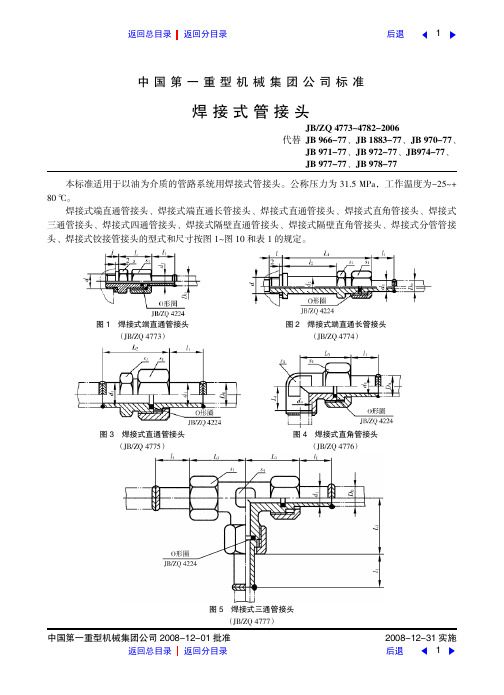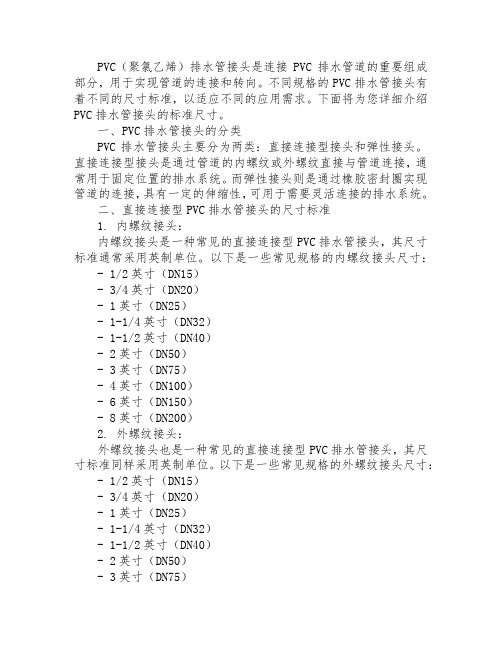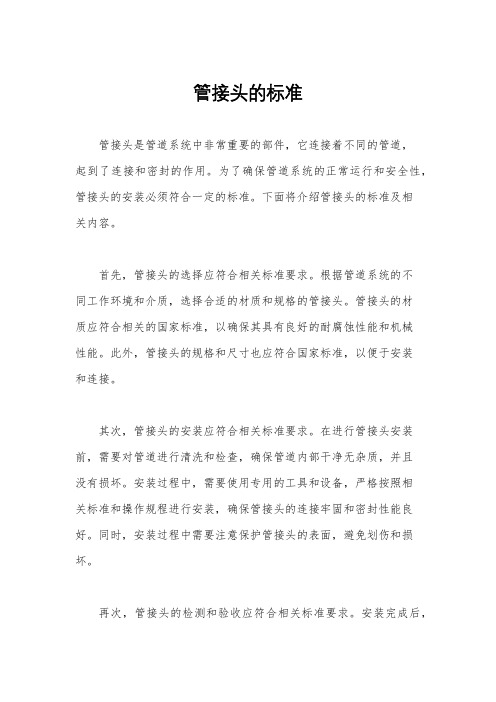各种管接头的标准
接头标准

一、卡套式管接头GB3733.1-83 卡套式端直通管接头 GB3735.1-83 卡套式端直通长管接头GB3737.1-83 卡套式直通管接头 GB3738.1-83 卡套式端直角管接头GB4740.1-83 卡套式直角管接头 GB3741.1-83 卡套式端三通管接头GB3743.1-83 卡套式端直角三通管接头 GB3745.1-83 卡套式三通管接头GB3746.1-83 卡套式四通管接头 GB3747.1-83 卡套式焊接管接头 GB3748.1-83 卡套式隔壁直通管接头 GB3749.1-83 卡套式隔壁直角管接头 GB3751.1-83 卡套式压力表管接头 GB3752.1-83 卡套式组合直角管接头 GB3753.1-83 卡套式组合三通管接头 GB3754.1-83 卡套式端对接直通管接头 GB3756.1-83 卡套式对接直通管接头 GB3757.1-83 卡套式端对接直角管接头 GB3759.1-83 卡套式管接头用螺母 GB3760.1-83 卡套式管接头用对接螺母 GB3761.1-83 卡套式管接头用锥体环 GB3764-83 卡套 JB1953-77 卡套式铰接管接头 JB1954-77 卡套式端直通变径管接头 JB1955-77 卡套式直通变径管接头 JB1956-77 卡套式端直角变径管接头二、扩口式管接头GB5625.1-85 扩口式直通管接头 GB5628.1-85 A型扩口式直通管接头GB5630.1-85 A型扩口式直角管接头 GB5631.1-85 扩口式可调向端直角管接头GB5632.1-85 扩口式组合直角管接头 GB5633.1-85 扩口式可调向端三通管接头GB5634.1-85 扩口式组合直角三通管接头 GB5637.1-85 扩口式可调向端直角三通管接头 GB5638.1-85 扩口式组合三通管接头 GB5639.1-85 A型扩口式三通管接头 GB5640.1-85 扩口式三通变径管接头 GB5641.1-85 扩口式四通管接头GB5642.1-85 扩口式焊接管接头 GB5643.1-85 扩口式隔壁直通管接头GB5644.1-85 扩口式隔壁直角管接头 GB5645.1-85 A型扩口式压力表管接头GB5646-85 扩口式管接头管套 GB5647-85 扩口式A型管接头螺母 GB5649-85 扩口式管接头锁紧螺母 GB5650-85 A型扩口管接头空心螺栓 GB5651-85 扩口式管接头A型密合垫 GB5652-85 扩口式管接头锁紧母垫圈 JB1912-77 扩口式铰接管接头三、焊接式管接头JB966-77 焊接式端直通管接头 JB1883-77 焊接式端直通长管接头JB970-77 焊接式直通管接头 JB971-77 焊接式直角管接头 JB972-77 焊接式三通管接头 JB973-77 焊接式四通管接头 JB974-77 焊接式隔壁直通管接头JB975-77 焊接式隔壁直角管接头 JB977-77 焊接式分管管接头JB978-77 焊接式铰接管接头 JB979-77 焊接式直角焊接接管 JB2099-77 焊接式管接头接管JB981-77 焊接式管接头用螺母 JB3878.1-85 插入焊接式直角管接头JB3878.2-85 插入焊接式三通管接头 JB3878.3-85 插入焊接式四通管接头JB3878.4-85 插入焊接式锐角三通管接头 JB3878.5-85 插入焊接式变径管接头JB3878.6-85 插入焊接式直通管接头JB3878.7-85 插入焊接式管封头JB/ZQ4202-86 锥密封焊接式端直通管接头 JB/ZQ4203-86 锥密封焊接式端直通园柱管螺纹管接头 JB/ZQ4226-86 锥密封焊接式端直通锥管螺纹管接头JB/ZQ4201-86 锥密封焊接式端直通锥螺纹管接头 JB/ZQ4205-86 锥密封焊接式90°弯管接头 JB/ZQ4206-86 锥密封焊接式园柱管螺纹90°弯管接头JB/ZQ4227-86 锥密封焊接式锥管螺纹90°弯管接头 JB/ZQ4204-86 锥密封焊接式锥螺纹90°弯管接头 JB/ZQ4207-86 锥密封焊接式直通管接头JB/ZQ4208-86 锥密封焊接式直角管接头JB/ZQ4209-86 锥密封焊接式三通管接头JB/ZQ4210-86 锥密封焊接式隔壁直通管接头JB/ZQ4211-86 锥密封焊接式隔壁直角管接头JB/ZQ4212-86 锥密封焊接式压力表管接头 JB/ZQ4412-86 锥密封焊接式管接头锥形接管JB/ZQ4415-86 锥形管堵四、焊接、卡套、扩口管接头通用标准另件JB982-77 组合密封垫圈套 JB999-77 管接头用铰接螺栓 JB1000-77 外六角螺塞 JB1001-77 内六角螺塞 JB1002-77 密封垫圈 GB3763-83 管接头用六角薄螺母 G38-3 60°圆锥管螺纹内六角螺塞 Q/ZB285-77 55°圆锥管螺纹内六角螺塞五、钢丝编织胶管接头JB1885-77 A型扣压式胶管接头 JB1886-77 B型扣压式胶管接头 JB1887-77 C型扣压式胶管接头 JB1891-77 扣压式接头螺母 JB1892-77 扣压式接头外套JB1893-77 A型扣压式胶管接头 JB1894-77 B型扣压式胶管接头 JB1895-77 C 型扣压式胶管接头胶管接头使用说明六、企业标准管接头 Q/AIG101.1-88 卡套式圆管螺纹端直通管接头Q/AIG102.1-88 卡套式60°圆锥管螺纹端直通管接头 Q/AIG103.1-88 卡套式55°圆锥管螺纹端直通管接头 Q/AIG104.1-88 卡套式圆柱管螺纹端直通长管接头 Q/AIG105.1-88 卡套式60°圆锥管螺纹端直通长管接头 Q/AIG106.1-88 卡套式圆锥管螺纹端直角管接头 Q/AIG107.1-88 卡套式60°圆锥管螺纹端直角管接头 Q/AIG108.1-88 卡套式55°圆锥管螺纹端直角管接头 Q/AIG109.1-88 卡套式圆柱管螺纹端三通管接头 Q/AIG110.1-88 卡套式60°圆锥管螺纹端三通管接头 Q/AIG111.1-88 卡套式55°圆锥管螺纹端三通管接头Q/AIG112.1-88 卡套式60°圆锥管螺纹端直角三通管接头 Q/AIG113.1-88 卡套式圆柱管螺纹铰接管接头 Q/AIG114.1-88 卡套式60°圆锥管螺纹端对接直通管接头 Q/AIG115.1-88 卡套式55°圆锥管螺纹端对接直通管接头Q/AIG116.1-88 卡套式60°圆锥管螺纹端对接直角管接头 Q/AIG117.1-88 卡套式55°圆锥管螺纹端对接直角管接头 Q/AIG118.1-88 卡套式组合直角三通管接头 Q/AIG119.1-88 卡套式组合端直通管接头 Q/AIG120.1-88 卡套式圆柱管螺纹组合端直通管接头 Q/AIG121.1-88 卡套式组合直通变径管接头Q/AIG122.1-88 卡套式焊接隔壁直通管接头 Q/AIG123.1-88 卡套式组合变径管接头 Q/AIG151.1-88 A型扩口式60°圆锥管螺纹端直通管接头 Q/AIG152.1-88 A型扩口式60°圆锥管螺纹端直通长管接头 Q/AIG153.1-88 A型扩口式60°圆锥管螺纹端直角管接头 Q/AIG154.1-88 A型扩口式60°圆锥管螺纹端三通管接头 Q/AIG155.1-88 A型扩口式60°圆锥管螺纹变径端三通管接头Q/AIG156.1-88 A型扩口式60°圆锥管螺纹端直角三通管接头 Q/AIG181.1-88 焊接式60°圆柱管螺纹端直通管接头 Q/AIG182.1-88 焊接式55°圆柱管螺纹端直通管接头 Q/AIG183.1-88 焊接式圆柱管螺纹端直通管接头 Q/AIG184.1-88 焊接式60°圆柱管螺纹端直通长管接头 Q/AIG185.1-88 焊接式60°圆柱管螺纹端直通长管接头 Q/AIG186.1-88 焊接式圆柱管螺纹端直通管接头Q/AIG201-88 管接头用圆柱管螺纹铰接螺栓 Q/AIG202-88 圆柱管螺纹外六角螺塞 Q/AIG203-88 圆柱管螺纹内六角螺塞以。
伊顿永华管接头标准

伊顿永华管接头标准
管接头是管道系统中连接管道的重要部件,它承载着管道的压力和载荷,保证
管道系统的安全运行。
伊顿永华作为管接头行业的领军企业,其管接头产品具有高质量、可靠性强的特点,深受广大用户的信赖和好评。
伊顿永华管接头的标准主要包括以下几个方面:
1. 材料标准。
伊顿永华管接头采用优质的材料制造,一般采用碳钢、不锈钢等材料。
这些材
料具有良好的耐腐蚀性能、高强度和良好的加工性能,能够满足不同工况下的使用要求。
2. 结构标准。
伊顿永华管接头的结构设计合理,具有良好的密封性能和承压能力。
其结构主
要包括管螺纹、法兰连接、对接焊接等形式,能够满足不同管道系统的连接需求。
3. 尺寸标准。
伊顿永华管接头的尺寸标准严格符合国际标准,能够与其他管道配件完美匹配,确保管道系统的连接稳固、安全。
4. 检测标准。
伊顿永华对其管接头产品进行严格的检测,确保产品质量符合标准要求。
常见
的检测方法包括压力试验、渗透试验、磁粉探伤等,以确保产品的可靠性和安全性。
5. 表面处理标准。
伊顿永华管接头的表面处理采用先进的防腐蚀工艺,能够有效延长产品的使用
寿命,保证管道系统的长期稳定运行。
综上所述,伊顿永华管接头标准严格,产品质量可靠,能够满足各种工况下的使用要求。
在实际工程中,用户可根据具体需求选择合适的管接头产品,以确保管道系统的安全运行。
同时,用户在使用伊顿永华管接头产品时,也应严格按照产品标准和使用说明进行安装和维护,以确保产品性能和使用寿命。
4种常用管道接头

谢谢!
5、检查 检查切割刃的切入深度。检查钢管是否在卡套前端受 挤压后形成了一个明显突起,并以将卡套前沿包住, 如已形成而且卡套在钢管上不能轴向移动,只能略微 转动说明预安装结束。
为了避免在卡套收紧时,钢管收缩变形,钢管壁厚不 能太薄,
对于φ8-φ15的钢管壁厚>1mm, φ16-φ18的钢管壁 厚>1.5mm, φ20-φ35的钢管壁厚>2.5mm,如必须 选用薄壁管,请在钢管内塞衬套,增加连接处壁厚。
气管接头
接头一般分两种,塑料接头和金属接头,
塑料接头的生产成本低些,制作工艺简单些,同时耐 压也只有1兆帕,
金属接头因制作工艺复杂,使用材料要求高,所以要 贵些,金属接头的耐压,耐高温,是一些高要求的环 境使用的首选
气管接头的特点
1.快速安装,简单灵巧,节省空间 2.形式多样,满足任何气动布管需要. 3.即使安装以后,塑料管也可以任意转向. 4.释放环采用椭圆形设计,拆卸更加省力方便. 5.所有锥管螺纹预涂聚四氟乙烯防漏胶,密封性能好
4种常用管道接头
螺纹标准
有美制、英制和公制
NPT是National (American) Pipe Thread的缩写,属于美 国标准的60度锥管螺纹,用于北美地区.国家标准可查阅 GB/T12716-1991
PT是Pipe Thread的缩写,是55度密封圆锥管螺纹,属惠 氏螺纹家族,多用于欧洲及英联邦国家.常用于水及煤气 管行业,锥度规定为1:16.国标准可查阅GB/T7306-2000
在一些用“о”形圈靠端面或外径密封的场合,其泄漏原 因有以下几种:
“о”形圈老化或变形而造成泄漏;“о”形圈装配不到位, 使两平面连接时压不平或“о”形圈被切割造成泄漏;“о” 形圈未压实,弹性变形量不足而造成泄漏;“о”形圈止 口槽过深而造成泄漏。
气动快插管接头 标准

气动快插管接头标准介绍气动快插管接头(Pneumatic Quick-disconnect Fittings),也称为气动快速接头,是一种常用的气动设备连接工具。
它采用快速连接和断开的设计,以实现高效、方便的安装和拆卸。
气动快插管接头经过严格的标准化设计和制造,以确保其质量、耐用性和可靠性。
本文将介绍气动快插管接头的标准及其特点。
气动快插管接头的标准气动快插管接头的标准通常由国际标准化组织(ISO)和国家标准化组织制定。
以下是一些常见的气动快插管接头标准:ISO 6150ISO 6150是气动快插管接头的国际标准之一。
该标准主要定义了气动快插管接头的尺寸、材料、性能要求等方面的规范。
通过遵循ISO 6150标准,可以确保气动快插管接头的互换性和兼容性。
ISO 7241ISO 7241是气动快插管接头的另一种国际标准。
该标准规定了气动快插管接头的连接口形状、连接方式、密封性能等方面的要求。
ISO 7241标准的应用范围广泛,适用于各种工业领域中使用的气动系统。
DIN 3489DIN 3489是德国工业标准化组织(Deutsches Institut für Normung)制定的气动快插管接头标准。
该标准详细规定了气动快插管接头的尺寸、材料、连接方式等技术要求。
DIN 3489标准的应用范围主要涵盖德国和欧洲地区。
气动快插管接头的特点气动快插管接头具有以下特点:快速连接和断开气动快插管接头采用简单的插拔设计,使得安装和拆卸过程更加迅速和高效。
它可以大大缩短线路的安装和维修时间,提高工作效率。
可靠的密封性能气动快插管接头采用优质的密封材料和密封结构,确保了连接口的密封性能。
它能够有效防止气体泄漏,提高气动系统的工作效率和安全性。
耐用性强气动快插管接头通常由耐腐蚀的材料制成,如不锈钢、铜等。
这些材料具有良好的耐用性和抗压能力,能够在恶劣的工作环境下长时间使用。
多种连接方式气动快插管接头提供多种连接方式,如直接插入、旋转锁定等。
焊接式管接头

中国第一重型机械集团公司标准焊接式管接头JB/ZQ 4773~4782-2006代替JB 966-77、JB 1883-77、JB 970-77、JB 971-77、JB 972-77、JB974-77、JB 977-77、JB 978-77中国第一重型机械集团公司2008-12-01批准2008-12-31实施本标准适用于以油为介质的管路系统用焊接式管接头。
公称压力为31.5MPa ,工作温度为-25~+80℃。
焊接式端直通管接头、焊接式端直通长管接头、焊接式直通管接头、焊接式直角管接头、焊接式三通管接头、焊接式四通管接头、焊接式隔壁直通管接头、焊接式隔壁直角管接头、焊接式分管管接头、焊接式铰接管接头的型式和尺寸按图1~图10和表1的规定。
图1焊接式端直通管接头(JB/ZQ 4773)图2焊接式端直通长管接头(JB/ZQ 4774)图3焊接式直通管接头(JB/ZQ 4775)图4焊接式直角管接头(JB/ZQ 4776)图5焊接式三通管接头(JB/ZQ 4777)1后退返回分目录返回总目录图6焊接式四通管接头(JB/ZQ4778)图7焊接式隔壁直通管接头(JB/ZQ4779)图8焊接式隔壁直角管接头(JB/ZQ4780)图9焊接式分管管接头(JB/ZQ4781)图10焊接式铰接管接头(JB/ZQ4782)标记示例:管子外径D0为18mm、螺纹直径d为22mm、螺距为1.5mm的焊接式端直通管接头:管接头18-M22×1.5JB/ZQ4773-2006管子外径D0为18mm、螺纹直径d为22mm、螺距为1.5mm的焊接式端直通长管接头:管接头18-M22×1.5JB/ZQ4774-2006管子外径D0为28mm的焊接式直通管接头:管接头28JB/ZQ4775-2006管子外径D0为28mm的焊接式直角管接头:管接头28JB/ZQ4776-2006管子外径D0为18mm的焊接式三通管接头:管接头18JB/ZQ4777-2006管子外径D0为88mm的焊接式四通管接头:管接头18JB/ZQ4778-2006管子外径D0为28mm的焊接式隔壁直通管接头:管接头28JB/ZQ4779-2006管子外径D0为28mm的焊接式隔壁直角管接头:管接头28JB/ZQ4780-2006管子外径D0为28mm的焊接式分管管接头:管接头28JB/ZQ4781-2006管子外径D0为28mm的A型焊接式铰接管接头:管接头28JB/ZQ4782-2006表1mm管子外径D0公称通径DNd d1d2d3d4(H12h12)d5D+0.6+0.4l l1l2l3l4L L1L2L3L4L5L6L7L863M10×17.5106.57-12814323-225430241222412620 106M10×1111010.5112216816.5354824.559.532.528.51525.544.530.521.5 106M14×1.51114----1216.535--25.560.5-------148M14×1.5161414.5162822121943510297241352029493827 148M18×1.51619----121943--2972-------1810M18×1.5191918.5193627122145712337845392233514229 1810M22×1.51924----142145--3378-------2215M22×1.5222422.5224630142148814348248432635554630 2215M27×22228----162148--3583-------2820M27×2282828.5285636162454915379153483039575132 2820M33×22834----162454--3993-------3425M33×2343434.534644216266510164611162573646626137 3425M42×23444----182665--48113-------4232M42×2424442.542785218287212175012268644048686839 4232M48×24250----202872--52124-------5040M48×2505050.550906020307815195613476744854747843新、旧标准代号对照管子外径D 0L 9L 10L 11L 12s s 1s 2s 3s 4s 5s 6s 7O 形圈JB/ZQ 4224垫圈质量,kgJB/ZQ4773JB/ZQ4774JB/ZQ4775JB/ZQ4776JB/ZQ4777JB/ZQ4778JB/ZQ4779JB/ZQ4780JB/ZQ4781JB/ZQ 47826---1517141414101717-8×1.9100.0390.0520.0280.0320.0640.0870.0770.0960.021-10238.51518171917171422221711×1.9100.0600.0820.0550.0680.1450.1900.1580.1830.0460.05910---191919-----11×1.9140.0710.103--------1429112023222722221930271916×2.4140.1430.2100.1500.1600.3700.5000.3440.3600.1200.10314---242724-----16×2.4180.1550.235--------1834132525273227272436322420×2.4180.1990.3250.1900.2500.5100.6800.5050.530.1600.19018---303230-----20×2.4220.2360.356--------2243173028303630302741363020×2.4220.2700.4360.2400.3100.6500.8800.600.670.2100.34222---363636-----20×2.4270.3200.480--------2850203532364136363250413630×3.1270.3900.6200.3700.4700.9201.2500.951.020.2800.66028---414141-----30×3.1330.4500.640--------3466272438465046464155504135×3.1330.6001.0000.6300.7601.5302.1801.681.970.4701.32034---555055-----35×3.1420.8501.224--------4282343044556055555065605540×3.1421.0601.6241.0501.2202.4003.8002.032.530.6702.14042---606060-----40×3.1481.1701.730--------5094383352657065656075706045×3.1481.6702.4301.5702.0503.9005.3003.343.841.0503.330注:1对于隔壁间无密封要求时,JB/ZQ 4784可省略。
pvc排水管接头标准尺寸

PVC(聚氯乙烯)排水管接头是连接PVC排水管道的重要组成部分,用于实现管道的连接和转向。
不同规格的PVC排水管接头有着不同的尺寸标准,以适应不同的应用需求。
下面将为您详细介绍PVC排水管接头的标准尺寸。
一、PVC排水管接头的分类PVC排水管接头主要分为两类:直接连接型接头和弹性接头。
直接连接型接头是通过管道的内螺纹或外螺纹直接与管道连接,通常用于固定位置的排水系统。
而弹性接头则是通过橡胶密封圈实现管道的连接,具有一定的伸缩性,可用于需要灵活连接的排水系统。
二、直接连接型PVC排水管接头的尺寸标准1. 内螺纹接头:内螺纹接头是一种常见的直接连接型PVC排水管接头,其尺寸标准通常采用英制单位。
以下是一些常见规格的内螺纹接头尺寸:- 1/2英寸(DN15)- 3/4英寸(DN20)- 1英寸(DN25)- 1-1/4英寸(DN32)- 1-1/2英寸(DN40)- 2英寸(DN50)- 3英寸(DN75)- 4英寸(DN100)- 6英寸(DN150)- 8英寸(DN200)2. 外螺纹接头:外螺纹接头也是一种常见的直接连接型PVC排水管接头,其尺寸标准同样采用英制单位。
以下是一些常见规格的外螺纹接头尺寸:- 1/2英寸(DN15)- 3/4英寸(DN20)- 1英寸(DN25)- 1-1/4英寸(DN32)- 1-1/2英寸(DN40)- 2英寸(DN50)- 3英寸(DN75)- 4英寸(DN100)- 6英寸(DN150)- 8英寸(DN200)三、弹性接头的尺寸标准弹性接头通常采用外径标准进行尺寸标注,以下是一些常见规格的弹性接头尺寸:- 50mm- 75mm- 110mm- 160mm- 200mm- 250mm- 315mm- 400mm- 500mm- 630mm四、其他特殊尺寸的PVC排水管接头除了上述常见尺寸的PVC排水管接头,还有一些特殊尺寸的接头用于满足特殊需求。
这些特殊尺寸的接头通常根据具体应用场景定制,其尺寸标准可能会有所不同。
内螺纹管接头标准规格型号【大全】

一. 螺纹的分类1. 螺纹分内螺纹和外螺纹两种;2.按牙形分可分为:1)三角形螺纹2)梯形螺纹3)矩形螺纹4)锯齿形螺纹;3.按线数分单头螺纹和多头螺纹;4.按旋入方向分左旋螺纹和右旋螺纹两种, 右旋不标注,左旋加LH,如M24×1.5LH;5.按用途不同分有:米制普通螺纹、用螺纹密封的管螺纹、非螺纹密封的管螺纹、60°圆锥管螺纹、米制锥螺纹等二. 米制普通螺纹1. 米制普通螺纹用大写M表示,牙型角2α=60°(α表示牙型半角);2. 米制普通螺纹按螺距分粗牙普通螺纹和细牙普通螺纹两种;2.1. 粗牙普通螺纹标记一般不标明螺距,如M20表示粗牙螺纹;细牙螺纹标记必须标明螺距,如M30×1.5表示细牙螺纹、其中螺距为1.5。
2.2.普通螺纹用于机械零件之间的连接和紧固,一般螺纹连接多用粗牙螺纹,细牙螺纹比同一公称直径的粗牙螺纹强度略高,自锁性能较好。
3. 米制普通螺纹的标记:M20-6H、M20×1.5LH-6g-40,M 表示米制普通螺纹,20表示螺纹的公称直径为20mm,1.5表示螺距,LH表示左旋,6H、6g表示螺纹精度等级,大写精度等级代号表示内螺纹,小写精度等级代号表示外螺纹,40表示旋合长度;3.1. 常用米制普通粗牙螺纹的螺距如下表(螺纹底孔直径:碳钢φ=公称直径-P;铸铁φ=公称直径-1.05~1.1P;加工外螺纹光杆直径取φ=公称直径-0.13P):3. 2米制普通螺纹的标记:M20-6H、M20×1.5LH-6g-40,M 表示米制普通螺纹,20表示螺纹的公称直径为20mm,1.5表示螺距,LH表示左旋,6H、6g表示螺纹精度等级,大写精度等级代号表示内螺纹,小写精度等级代号表示外螺纹,40表示旋合长度;3.3. 常用米制普通粗牙螺纹的螺距如下表(螺纹底孔直径:碳钢φ=公称直径-P;铸铁φ=公称直径-1.05~1.1P;加工外螺纹光杆直径取φ=公称直径-0.13P):3. 4米制普通螺纹的标记:M20-6H、M20×1.5LH-6g-40,M 表示米制普通螺纹,20表示螺纹的公称直径为20mm,1.5表示螺距,LH表示左旋,6H、6g表示螺纹精度等级,大写精度等级代号表示内螺纹,小写精度等级代号表示外螺纹,40表示旋合长度;3.5. 常用米制普通粗牙螺纹的螺距如下表(螺纹底孔直径:碳钢φ=公称直径-P;铸铁φ=公称直径-1.05~1.1P;加工外螺纹光杆直径取φ=公称直径-0.13P):。
管接头的标准

管接头的标准管接头是管道系统中非常重要的部件,它连接着不同的管道,起到了连接和密封的作用。
为了确保管道系统的正常运行和安全性,管接头的安装必须符合一定的标准。
下面将介绍管接头的标准及相关内容。
首先,管接头的选择应符合相关标准要求。
根据管道系统的不同工作环境和介质,选择合适的材质和规格的管接头。
管接头的材质应符合相关的国家标准,以确保其具有良好的耐腐蚀性能和机械性能。
此外,管接头的规格和尺寸也应符合国家标准,以便于安装和连接。
其次,管接头的安装应符合相关标准要求。
在进行管接头安装前,需要对管道进行清洗和检查,确保管道内部干净无杂质,并且没有损坏。
安装过程中,需要使用专用的工具和设备,严格按照相关标准和操作规程进行安装,确保管接头的连接牢固和密封性能良好。
同时,安装过程中需要注意保护管接头的表面,避免划伤和损坏。
再次,管接头的检测和验收应符合相关标准要求。
安装完成后,需要进行管接头的检测和验收,以确保其符合相关标准和要求。
检测内容包括外观检查、尺寸检测、密封性能检测等,验收内容包括材质证明、规格证明、安装记录等。
只有通过了严格的检测和验收,管接头才能投入使用。
最后,管接头的使用和维护应符合相关标准要求。
在使用过程中,需要定期对管接头进行检查和维护,确保其正常运行和安全性能。
对于老化和损坏严重的管接头,需要及时更换,以免影响整个管道系统的正常运行。
同时,使用和维护过程中需要遵守相关的操作规程和安全规定,确保工作人员的人身安全。
综上所述,管接头的标准涉及到材质选择、安装、检测验收、使用维护等多个方面,只有严格按照相关标准要求进行操作,才能保证管接头的质量和安全性能。
因此,在管道系统的设计和施工过程中,需要严格遵守相关标准,确保管接头的质量和安全。
- 1、下载文档前请自行甄别文档内容的完整性,平台不提供额外的编辑、内容补充、找答案等附加服务。
- 2、"仅部分预览"的文档,不可在线预览部分如存在完整性等问题,可反馈申请退款(可完整预览的文档不适用该条件!)。
- 3、如文档侵犯您的权益,请联系客服反馈,我们会尽快为您处理(人工客服工作时间:9:00-18:30)。
Standard Pipe Threads
There are many pipe thread specifications but they fall into one of two categories: The North American or US Standard and the Rest of the world.
The US has the National Standard Pipe Thread designated NPT and a variation of it, the dryseal thread designated NPTF. They are really the same thread. The dryseal thread differs in that the roots of the threads are slightly more truncated than the crests. The dryseal was designed to be sealed without thread sealant. If you are going to use thread sealant anyway, the fittings can be used interchangeably. Sometimes you will see NPTF used to designate National Pipe Thread Female and NPTM for National Pipe Thread Male. If someone tries to tell you this, insult them properly for being idiots.
The rest of the world is based off of the British Standard Pipe Threads. There are tapered and straight thread versions. Sometimes you will hear them called BSPT and BSPP respectively. The British don't call their threads that. They designate them as "R" and "R Tr" respectively. Germany, France, and Japan all have their own names for the threads. They are shown in the table.
The National Standard and the British Standard also differ in that their pitches or threads per inch are slightly different. If you pick up two fittings they will almost go together. Don't try to put them together though. At best, you'll just ruin both fittings. Only the nominal 1/2" and 3/4" have the same pitch. Still, don't try to put them together (it may work) because the thread forms are slightly different and you may have a difficult time putting them together.
Why the two thread systems are similar but not quite the same is a mystery to me. My theory (being an American) is that it was invented here and the Brits couldn't stand it so they changed it just slightly so they would never have to use an American made product. The rest of the Europeans (and Japan) couldn't stand using an English thread and further changed the name and called it metric. I'm sure the rest of the world would say that it was the Americans that changed it and made our own
Pipe is identified by it's nominal size. Originally, the OD of pipe was defined by it's ID. Given a wall thickness suitable to holding the required pressure (using the materials at the time) the OD was determined. With the advent of modern steels, the OD has remained constant and the ID has increased. Different wall thicknesses are now available to handle different pressures. They are defined by the ASME Boiler and Pressure Vessel Code and are designated as the Schedule number. Schedules 20, 40, 80, and 160 defined but the most common are Schedules 40 and 80.
Tubing is designated by its OD. A 1/2" tube ha a 1/2" outside diameter. It's inside diameter is something less. Hose on the other hand is designated by it's ID. A 1/2" hose has a 1/2" inside diameter. It is common practice when plumbing systems with hose, pipe, and tubing to use tubing the next nominal size up from the hose. Hose and pipe are typically plumbed at the same nominal size. Even though most Schedule 40 and 80 pipe has a larger ID, it is also rougher and the increased diameter。
